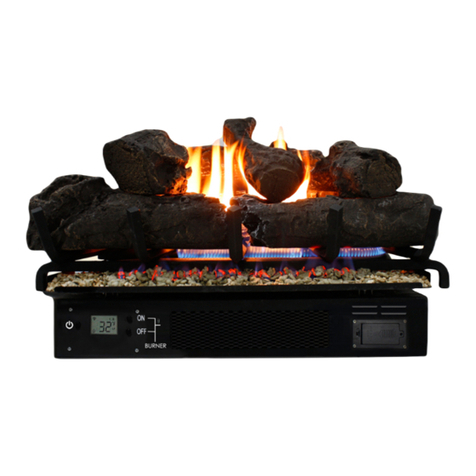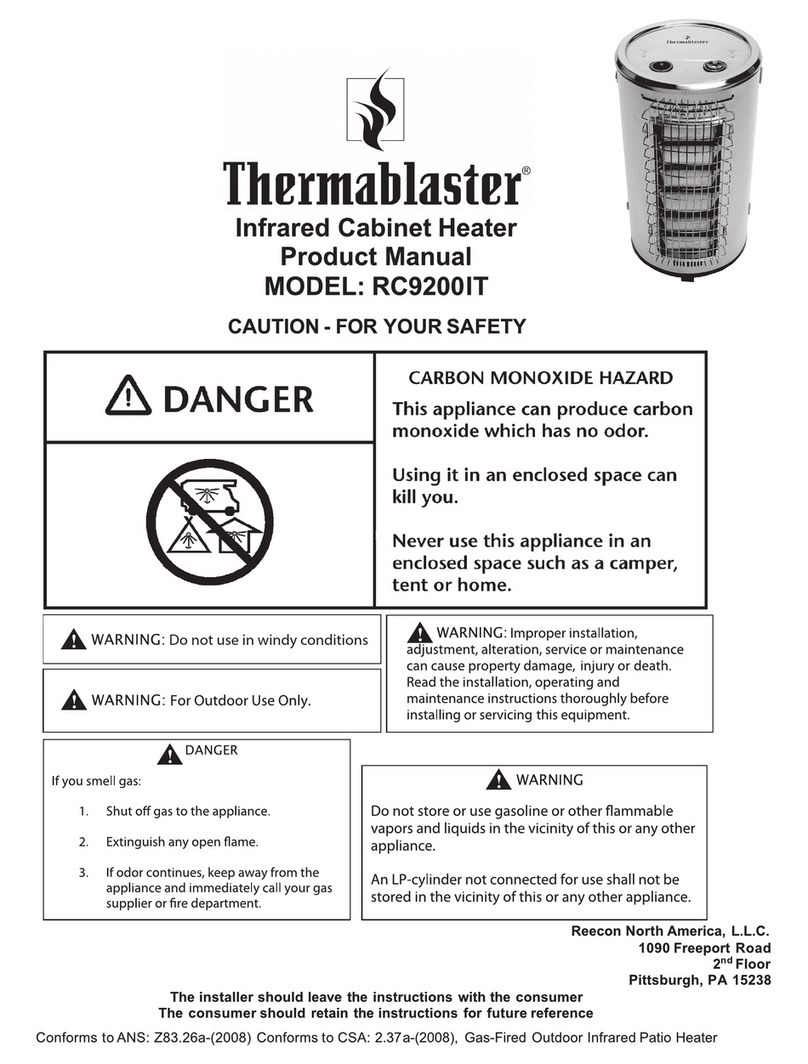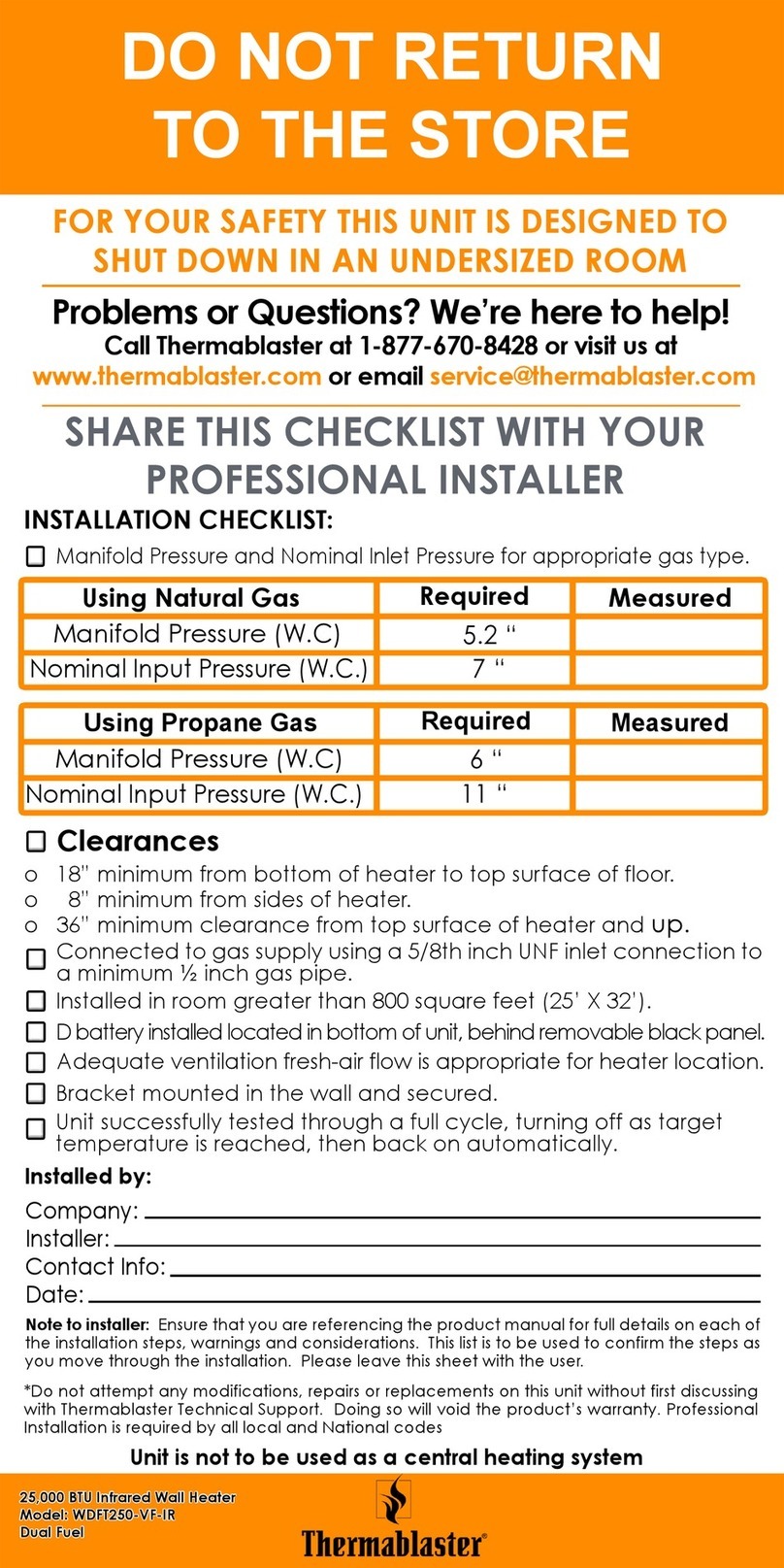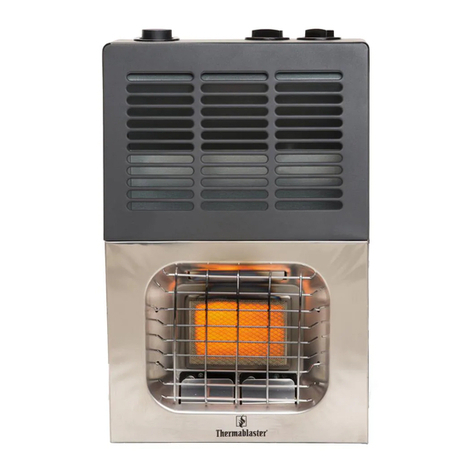
12
No. PROBLEM POSSIBLE CAUSE REMEDY
1 When igniter button is pressed in
there is no spark at ODS/pilot.
1. Igniter electrode is positioned
wrong or broken.
2. Igniter electrode is not connected to
igniter cable.
3. Igniter cable is pinched or wet.
4. Broken igniter cable.
5. Bad piezo igniter.
1. Replace igniter.
2. Reconnect igniter cable.
3. Free igniter cable if pinched by any
metal or tubing. Keep igniter cable dry.
4. Replace igniter cable.
5. Replace piezo igniter.
2 When igniter button is
pressed in there is a spark
at ODS/pilot but no ignition.
1. Gas supply is turned off or
equipment
Shutoff valve is closed.
2. Control knob not fully pressed in
while
pressing igniter button.
3. Air in gas lines when installed.
4. ODS/pilot is clogged.
5. Gas regulator setting is not correct.
6. Control knob not in PILOT position.
7. Depleted gas supply (propane).
1. Turn on gas supply or open equipment
shutoff valve.
2. Fully press in control knob while
pressing igniter button.
3. Continue holding down control knob.
Repeat igniting operation until air is
removed.
4. Clean ODS/pilot (see Care and
Maintenance, page 9) or replace ODS/
pilot assembly.
5. Replace gas regulator.
6. Turn control knob to PILOT position.
7. Contact local propane/LP gas company.
3 ODS/pilot lights but flame
goes out when control
knob is released.
1. Control knob is not fully pressed in.
2. Control knob is not pressed in long
enough.
3. Equipment shutoff valve is not
fully open.
4. Thermocouple connection is loose
at control valve.
5. Thermocouple damaged.
6. Control valve damaged.
1. Press in control knob fully.
2. After ODS/pilot lights, keep control knob
pressed in 30 seconds.
3. Fully open equipment shutoff valve
4. Hand tighten until snug, and then
tighten 1/4 turn more.
5. Replace thermocouple.
6. Contact customer service.
4 Burner(s) does not light
after ODS/pilot is lit.
1. Burner orifice is clogged.
2. Burner orifice diameter is too small.
3. Inlet gas pressure is too low.
1. Clean burner orifice (see Care and
Maintenance, page 10) or replace
burner orifice.
2. Contact customer service.
3. Contact local gas supplier.
5 Delayed ignition of
burner(s).
1. Manifold pressure is too low.
2. Burner orifice is clogged.
1. Contact local gas supplier.
2. Clean burner (see Care and
Maintenance, page 10) or replace
burner orifice.
6 Burner backfiring
during combustion.
1. Burner orifice is clogged or
damaged.
2. Burner is damaged.
3. Gas regulator is defective.
1. Clean burner orifice (see Care and
Maintenance, page 10) or replace.
2. Contact customer service.
3. Replace gas regulator.
7 Yellow flame during
burner combustion. 1. Not enough air.
2. Gas regulator is defective.
3. Inlet gas pressure is too low.
1. Check burner for dirt and debris. If
found, clean burner (see Care and
Maintenance, page 10).
2. Replace gas regulator.
3. Contact local gas supplier.
8 Slight smoke or odor
during initial operation.
1. Residues from manufacturing
processes.
1. Problem will stop after a few hours of
operation.
9 Heater produces a
whistling noise
when burner is lit.
1. Turning control knob to HI position
when burner is cold.
2. Air in gas line.
3. Air passageways on heater are
blocked.
4. Dirty or partially clogged burner
orifice.
1. Turn control knob to LO position and let
warm up for a minute.
2. Operate burner until air is removed
from line. Have gas line checked by
local gas supplier.
3. Observe minimum installation
clearances (Section 5 page 7).
4. Clean burner (see Care and
Maintenance, page 10) or replace






































